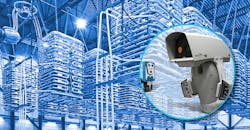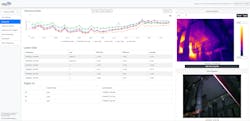The Challenge
High Voltage Direct Current, (HVDC), is the most efficient way to transmit electricity over long distances and is increasing in deployments as electric power consumption grows and more cost-effective solutions are required to bring power from remote locations to consumers. Reliability of the assets in the HVDC converter hall is critical as they are the key active components of the system that perform the AC/DC voltage conversion. Due to the hazardous conditions inside the converter hall, manual inspections are not possible while the system is energized. Manual inspections of the converter pose a variety of challenges: i) inspecting a de-energized system with infrared sensors will miss problem hot-spots and leakages that only occur while the system is under operation ii) inspections can only be done infrequently when an outage is scheduled and may miss problems that occur in between inspections iii) ground-based inspections of a five story high convertor hall can miss problems in hard to see locations.
Background
Failures in HVDC Systems can stem from problems in the converter hall where the active elements in the system are housed. The power conversion process that takes place in the converter hall generates heat energy and requires a cooling system to maintain correct operation. A large percentage of problems in an HVDC system are due to defects in the active power conversion components and in the cooling system itself. These problems can worsen over time and lead to failures if not detected and corrected in time. There are high levels of Electromagnetic Interference, (EMI), inside the converter hall that can cause mis-operation of electronic equipment. Equipment that is used to monitor the HVDC system must have adequate levels of EMI protection so that it is not affected by EMI and cannot cause interference to any of the HVDC control equipment in the converter hall. The monitoring equipment must be substation rated so that it is able to operate reliably in a high EMI environment.
The Solution
An automated visual and thermal inspection system inside the HVDC converter hall will monitor the equipment continuously without having to take an outage and will not miss transient problems or problems that occur in between manual, periodic inspections. Since the converter hall does not have to be de-energized, the equipment is monitored under load so that heat related defects will be detected. The thermal sensors are contactless, able to monitor temperatures on HVDC equipment and its cooling system without physical attachment. The thermal sensors can be installed on pan and tilt bases so they can be optimally positioned and programmed to monitor multiple points. Sensors can be installed in hard-to-reach places to ensure all the critical points in the converter hall are covered. The monitoring system sends temperature data and images to a standalone visualization software or may be integrated with the utility's SCADA or asset management application for further analysis, trending and health indexing. Any temperature related anomalies that the monitoring system detects will be sent as alarms to the SCADA system or to email so operators can investigate and take corrective maintenance actions.
Figure 1 – Substation rated sensors are required to withstand the high levels of EMI in the Converter Hall. Integration with remote monitoring and asset management applications allow for health tracking and maintenance scheduling.
The Touchless thermal and visual sensors must be utility grade, complying to stringent standards such as IEEE-1613 and IEC61850-3, having no moving parts and meeting operating temperatures of -40 to +85 degrees Celsius. With the data in hand to evaluate the health of the equipment inside the converter hall, utilities can make informed decisions about when to perform maintenance based on the asset condition.
Summary
The automated monitoring system allows utilities to perform remote inspections, with continuous monitoring on sites and equipment that would otherwise be difficult and costly to inspect. The automated system provides visual and thermal imaging of the assets inside the HVDC converter hall without sending personnel to site and without taking an outage. Contactless technology allows the infrared sensors to be installed easily and to monitor hundreds of points from a single sensor. Temperature data is sent to SCADA or PI applications for further analysis, trending and input to asset management applications. Continuous thermal monitoring ultimately improves utility safety and reliability while reducing operating costs.
For more information contact us at [email protected], or visit our website at www.systemswithintelligence.com.
Sponsored By:


